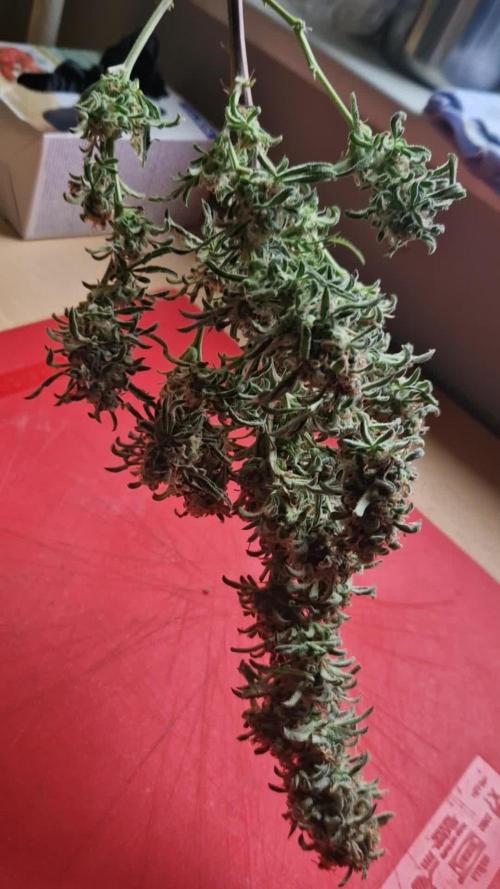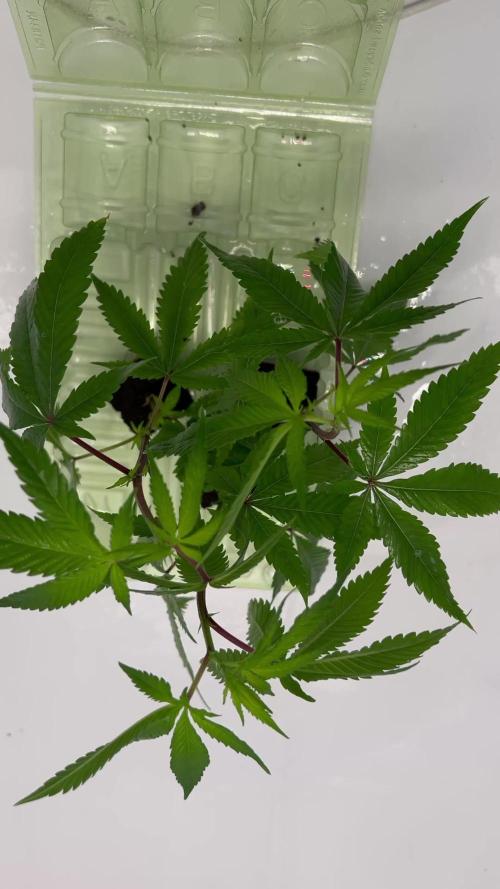The Grow Awards 2026 🏆 































Likes
Comments
Share


@barlobruz
Follow
08/04/2021
- I SEE PISTILLS!!! Really didn't think we'd make it this far 😅
08/08/2021
- Top dressed and watered w/ an AAEWCIF tea.
- Continuing to defol as necessary.
- Too lazy to date and re-organize all those photos through the phone.
- Photos taken from 08/02/2021-08/08/2021.
Processing
Likes
13
Share


@ladyjane
Follow
8/10 - In prep for flower I've got some Compost Tea brewing with a little Terp Tea Bloom by Roots Organics. .Also did a little selective defoliation
8/11 - Flipped the ladies to flower today! And all is good in the 8x4.
8/12 - Watered all the ladies with the Compost/Terp Tea. Also did some more defoliation and added some mosquito bits for added pest prevention.
Likes
5
Share


@Wenz004
Follow
experiment explanation see week1
This week both different living soil experiments Tropicana No2 and No3 did not grow anymore...only the flowers got a bit bigger...especially No3
Likes
Comments
Share


@SirNoodlesGrow
Follow
Awesome Strain, but low yield. Will try another time but then i will have a look to change something on the grow to get more yield.
Likes
13
Share


@Flowers_By_Irene
Follow
Partially drained the tank at the start of the week and topped up with ro water and 1ml of final solution per Litre. Last 2.5 days were in darkness.
I trimmed the majority of fan leaves before hanging up to dry in the tent today. Started out trimming with the plants in the tent and soon realised it would be much easier to just cut them down whole, hang them upside down outside the tent and trim them up a bit.
I have a small dehumidifier and a small fan heater setup in the tent and they have been keeping a humidity level of about 60% and a temp of 16 Celsius for the last few days while the lights have been off. I figure that's a good starting point for drying and I can increase the temperature if needed, that will drop the humidity also.
Intake fan at the bottom and extract fan at the top are running constantly as they have been since the grow started (low power 4" fans).
I might add back in a fan for circulation depending on how the drying goes, or maybe even trim or hang the plants better to get more airflow around the buds
Likes
24
Share


@OGOZHigh
Follow
Update : 09.06
Da das Wetter hier im Norden nicht so mit spielt, machen sie langsam Fortschritte.
Wir machen das beste Draus ✌️
Likes
28
Share


@w33dhawk
Follow
Hallo meine Freunde des gepflegten Grow sports! 💐
Die Damen sind abgehackt und aufgehangen davor habe ich alle Fächer Blätter entfernt noch als die Pflanzen im Zelt standen heut morgen Ach ja wir haben den 26.04.23 nur so zur Info 😂😂 danach habe ich alle Damen also 4stk an der Zahl genau unter dem ersten Knoten entfernt das gesamte ScroG netzt abgegangen umgedreht und wieder an gehangen (bin irgendwie faul diesmal) war die schnellste und einfachste Lösung und somit wurde aus dem ScroG netzt ein trocken netz 😂🍾😂 Jetzt heisst es warten bis sie trocken sind wie man sehen kann auf dem letzten Video überwache ich weiter die Temperatur und Feuchtigkeits Werte! liegen bei 50% rlf und guten 16 Grad, denke mal in 10 bis 14 Tagen werde ich dann diesen Bericht als ernte ein tragen da die Damen dann in die Gläser gehen werden zum curing, feucht Gewicht kann ich grad nicht sagen, da ich sie ja nicht aus dem netzt entfernt habe aber so bald sie in die Gläser wandern werden sie gewogen
Ach ja bevor ich es vergesse habe die Basis der Pflanze dran gelassen da sonnst einiges aus dem netzt fallen würde ohne Befestigung. Wir lesen uns dann in ca 14 Tagen wieder wenn alles soweit fertig ist euch allen einen erfolgreichen Grow und bis die Tage 🖖🤘✌️👋
Likes
52
Share


@blazin_skywalker
Follow
Day 9 - These plants are growing immaculately. Dark green, thick, healthy leaves, no stretching, they're growing like an absolute dream.
Since removing them from the run-off catching orange cups, they have happily air pruned themselves and are continuing to beast out. 💪
I've only watered them once on day 5 so far. I've been warned by other growers that M3 is very easy to accidentally over water, so I am keeping that on my mind with every check.
Day 10 - Noticed some pale spots on one of my seedlings. It's only on the second true leaves of one plant. Gave them a watering with 6.5 pH water
Day 11 - Spots on one of my plants still there, taking up a little more space on the leaves. Still only present on the second true leaves of this plant. The plant appears otherwise happy and healthy. All three others are green and mean. 💪
Day 12 - Transplanted these little lovies into 1 gallon pots. Gave a light watering to just the outer ring of the pot with 6.5 pH water. My Step-Veg program for my California Lightworks Solar System 550 has been gradually increased to R80 W80 B99.
First time transplanting anything outside of a seedling before, I was embarrassingly nervous. Made sure to get a ton of pictures of each one because I'm Mom af. 😂
Anyway - excited to see how many ladies I can score this round! Please give me at least one! 💜🙏💙
Day 14 - Closing out a beautiful week. I'm still unsure of what is causing the spots on one of my plants. I've gotten many suggestions of pests, but I've spent at LEAST a cumulative 4 hours over the past 2 days with her under the microscope, combing the leaves like an overprotective mother, and I have seen zero suspicious microscopic gang activity.
As a precaution, I mixed some neem oil and dish soap and sprayed all the plants at lights out.
Storytime was a big hit with the kids. 🤣💜
Likes
21
Share


@puffin_ganja
Follow
Did a medium defoliation in the middle of week 4 prob around day 25. Everything is going smooth and I will most likely add another layer of trellis once they start packing on more weight.
Likes
8
Share


@Alex_mir_doch
Follow
viel hat sich nicht mehr getan seit dem letzten eintrag. so richtig bernsteinig wollten die trichome nicht werden obwohl ich den pflanzen zwei wochen mehr zeit als geplant eingeräumt habe.
zum trocknen hab ich die nur grob getrimmt. die feinarbeit kommt nach dem trocknen.
da im zelt noch die white truffle stehen hängen die freaks erstmal im schrank.
die bedingungen zum trocknen sind wetterbedingt gerade sehr schlecht. bei 70% raumluftfeuchtigkeit wird so schnell nix trocknen.
vielleicht wird es ja doch noch sommer in den nächsten tagen.
Likes
4
Share


@Mario_buds
Follow
THESE ARE OUTDOORS LOOKING HEALTH AND GOOD GROWTH WILL BE PLANTED THEM IN THE GROUND SOON PLEASE FOnLLOW MY YOUTUBE ACCOUNT MARIO BUDS HERES THE LINK https://www.youtube.com/channel/UCrChGA3BfQXleGJficvD8XQ
Likes
82
Share


@MrHightimes
Follow
These plants are getting huge!!! I supercropped em down tonight and gave em a full blast of feed! I'm trying to keep leaves on but i did give them a small trim.
they seem to be catching up to each other, I hope they will level out! They are gonna be big plants tho fo sho!
Going to transfer tents this week probably.
____________________________________________________________________________
Moved them into the big tent! its snug, but they should be happy! Getting HUGE!
______________________________________________
I felt like they were in all their glory tonight! I got in there and gave em a big ol haircut and pulled out all the lower garbage.
With the use of several spacers I really feel like I opened em up nicely and primed em up for some big buds to form.
Two plants are def gonna be purple. We'll see about the other 2.
Likes
2
Share


@smoking_hills9
Follow
Top strain, very easy 2 grow with amazing results in the end. Didn't try it yet, but when I hit it , I will definitely update on here. Smells a bit pissy like dirty dog and colours are fantastic . One more waiting 2 be chopped.
So final results are 275gr of quality solid purple buds🤩✔️ that's not include the bottom trim and small buds.
Total harvest weight is 5kg of quality solid buds and around 2kg of bottom small buds
Likes
31
Share


@Dunk_Junk
Follow
So she grew 26cm this week... Over doubling her height!!!!!!!! I think she's just entered flowering.
All in all, she's growing well 😎
Processing
Likes
8
Share


@Lazuli
Follow
21 July: start flowering
i took clones 4days ago that will veg bigger but for now i want to flower early as i think this plant will stretch more then the indicas im used to.
Likes
35
Share


@Mrs_Larimar
Follow
March 11th.
All Seedlings are stable, Looking good
Working on Leafset 4
Rooting job is done, now the allover development can Start
Plants are sitting in 3l Pots, filled with my Soilmix
Watering with Beneficals
Spraying with Foliar Feed " Fast Plants Spray"
March 13th.
Iam done with setting up
Now i have another Babytent. and Inside the New Viparspectra XS-1000
and the other Stuff to run the Envoirement
I already ca see a difference between both Tents. If you stand outside and just look with Eyesight
the Viparspectra seems to be brighter// has another color of Light.
I made a Unboxing Video for more informations.
Amazon: http://url-9.cn/0y9i
Amazon US: https://amzn.to/3e0P2bk
Amazon CA: https://amzn.to/3bTnEJC
Amazon discount Code:
it10mlarimar XS1000 10%
it15mlarimar XS1500 5%
it20mlarimar XS2000 5%
it40mlarimar XS4000 5%


























